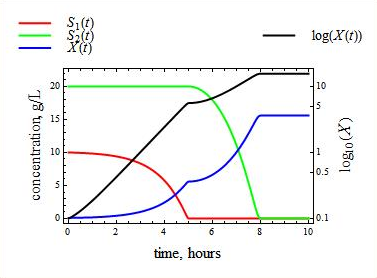Team:Imperial College London/Autoinduction
From 2009.igem.org

Please delete as completed.
Autoinduction feedback from todays session.
1) Mention the purpose of AI - No timer because...
2) Don't link to the temporal control page here.
3) Have a rationale section.
4) Add what teams can reuse from this module.
5) Have a conclusion of the page at the end - couple of lines.
Contents |
Module Integration - Autoinduction
Overview
Initiation
Module 2 is triggered by a rise in levels of cyclic Adenosine Mono Phosphate (cAMP). This is because cAMP facilitates the dimerisation of the transcription factor CRP which induces transcription downstream of the PcstA promoter. The rise in cAMP is correlated with a fall in levels of the primary carbon source (glucose). Thus, by controlling the initial amount of glucose present in the system, we achieve a timer function for the start of Module 2.
 About Module 2 temporal control.
About Module 2 temporal control.
Results
We have modelled autoinduction by a number of models, and we hope that experimental results will confirm which model is most applicable to our system.The first of our diauxic growth models is a cybernetic model developed by Kompala et al [1]. This model shows that glucose (S1) is used up before the secondary carbon source (S2). During this phase, the population (X) is in exponential grow until glucose (S1) runs out. This is followed by a stationary growth phase, and finally the population enters a second exponential growth phase as they start uptaking the secondary carbon source (S2). Another model was developed by Keasling [2] that takes into account the dynamics of the lactose operon. //Include a nice diauxic growth curve from the lab
 About the models and simulations!</i>
About the models and simulations!</i>


 "
"







